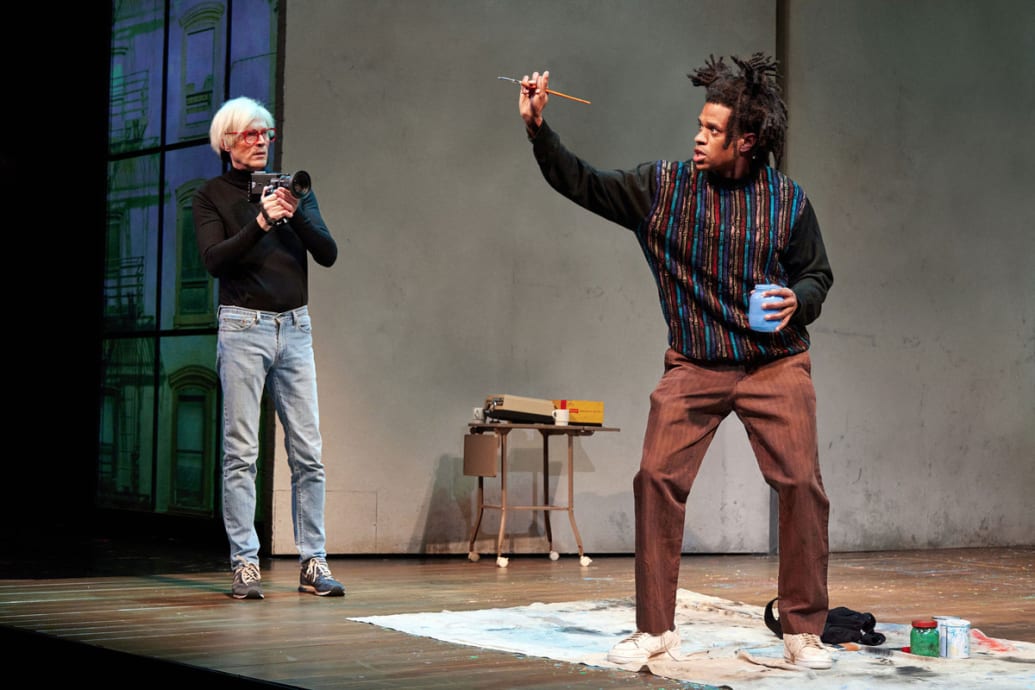The acoustics of Broadway’s Samuel J. Friedman Theatre are not only unkind to the four performers of The Collaboration (to January 29); swathes of dialogue are lost to the theater’s puzzling physical atmosphere. Happily, this does not go for the pulsing, fabulous ‘80s pop that welcomes the audience into this Manhattan Theatre Club show, and which punctuates scene changes. This author particularly liked hearing Bronski Beat’s “Smalltown Boy,” a classic gay anthem of declaration and escape that feels particularly piercing when thinking about the play’s protagonist’s Andy Warhol (Paul Bettany) and Jean-Michel Basquiat (the Emmy and Tony-nominated Jeremy Pope).
Anthony McCarten’s play imagines the mix of confrontation, competition, flirtation, care, and understanding that blooms between the two legendary artists when brought together to collaborate on a group of paintings made in the mid-1980’s, now worth many millions of dollars. At the time Warhol was already the superstar and iconic cultural changemaker that he is still known as today. Basquiat’s legend was in progress, red-hot and still coalescing. Initially, they both wonder what they have to both gain and lose by working together.
The acoustics, and the effect they have on the staging of a play which already feels too set back from the audience, are a shame; Bettany and Pope are both stars and brilliant actors, and the play was warmly received when it first played in London this year. Filming for the big screen has just been completed on The Collaboration, and a movie may turn out to be the better format to appreciate both men’s performances.
The handsome Pope brings a crackling energy to Basquiat, darting this way and that in the studio where the works are created; the tall and slim Bettany is laconic in his trademark Warhol silver wig. Both men try to provoke the other—Basquiat by mocking Warhol as a hack who really should do some painting; while Warhol tries to pierce Basquiat’s cool by filming him, which Basquiat clearly loathes, at least initially. Until the very end, when they get down on their knees to paint, the canvases they work on are imagined at the front of the stage, which means both actors look directly out at the audience as they contemplate what they are making; Basquiat looking as if he is spoiling for a fight, while Warhol looks fantastically disappointed at the world.
Out of the men’s jabs and jibes—with Basquiat trying to make Warhol aware of racism, particularly when it comes to law enforcement—comes mutual understanding and respect for what each one does, and then something deeper when Warhol becomes keenly aware of Basquiat’s drug addiction; Warhol makes clear the younger man is far from the first addict he has known.
Paul Bettany as Andy Warhol and Jeremy Pope as Jean-Michel Basquiat in ‘The Collaboration.’
Jeremy Daniel
But what do we end up knowing of Warhol and Basquiat that couldn’t be gleaned from Wikipedia or biographies at the end of this? Not much. Perhaps that is inevitable with the very famous and very written about, but when fiction tackles such totemic figures one hopes that dramatic license at least would open a new crack in understanding, or something more playful and mischievous in analyzing much-revered legends. The Collaboration only does this in the moments it imagines the intimacy between the two men, which seems first almost aggressive, then flirty, then platonic, then almost parental on Warhol’s part.
In underwritten roles, Krysta Rodriguez plays Maya, a composite girlfriend of Basquiat’s; she provides the play’s visual surprise of a refrigerator literally filled with dollar bills. Erik Jensen plays gallerist Bruno Bischofberger, and is such an intriguing presence you only wish he was given more to do that inveigle the men into the collaboration. But his presence and that fridge brimming with cash underline the central theme of the play: the vexed relationship of money and value in art—stratospheric dollar figures which ultimately dwarf the passion, personalities, and meaning behind artistic creation.
The urgency of the second act, and the energetic peaks in the men’s performances—particularly Pope’s—give The Collaboration some much-needed electricity, but the stilted staging of the play leaks power and focus from a show which determinedly keeps its protagonists a mystery.










